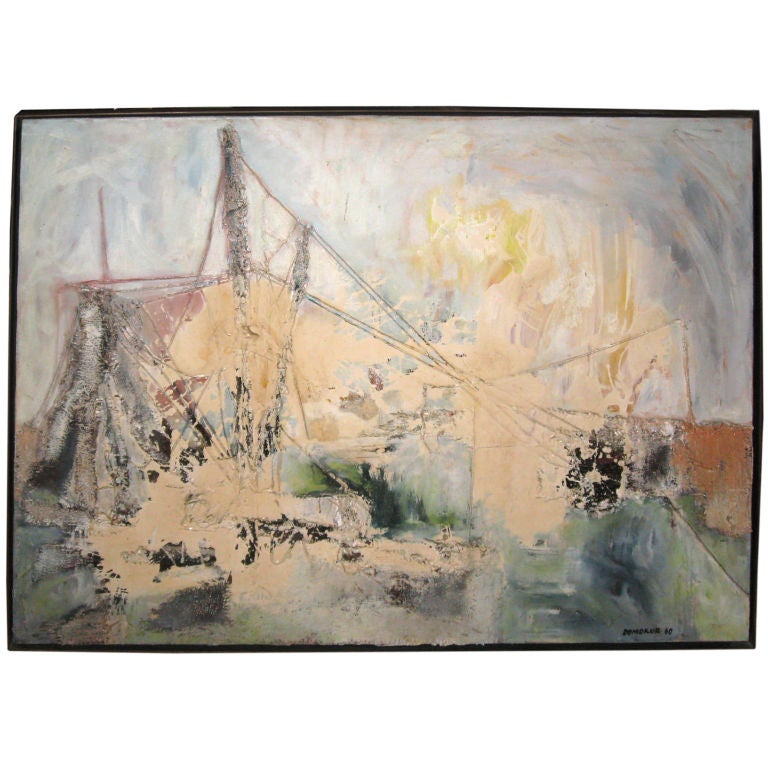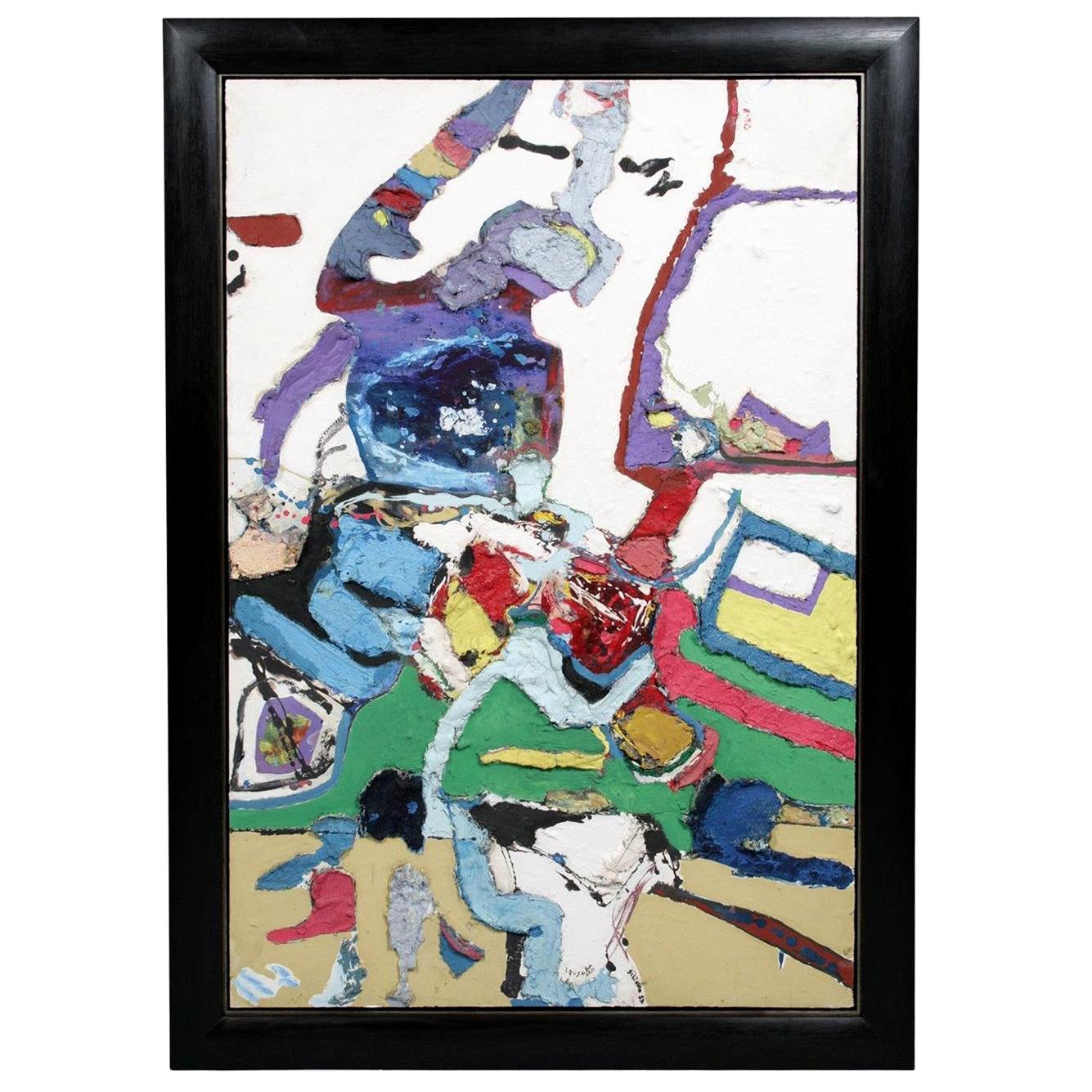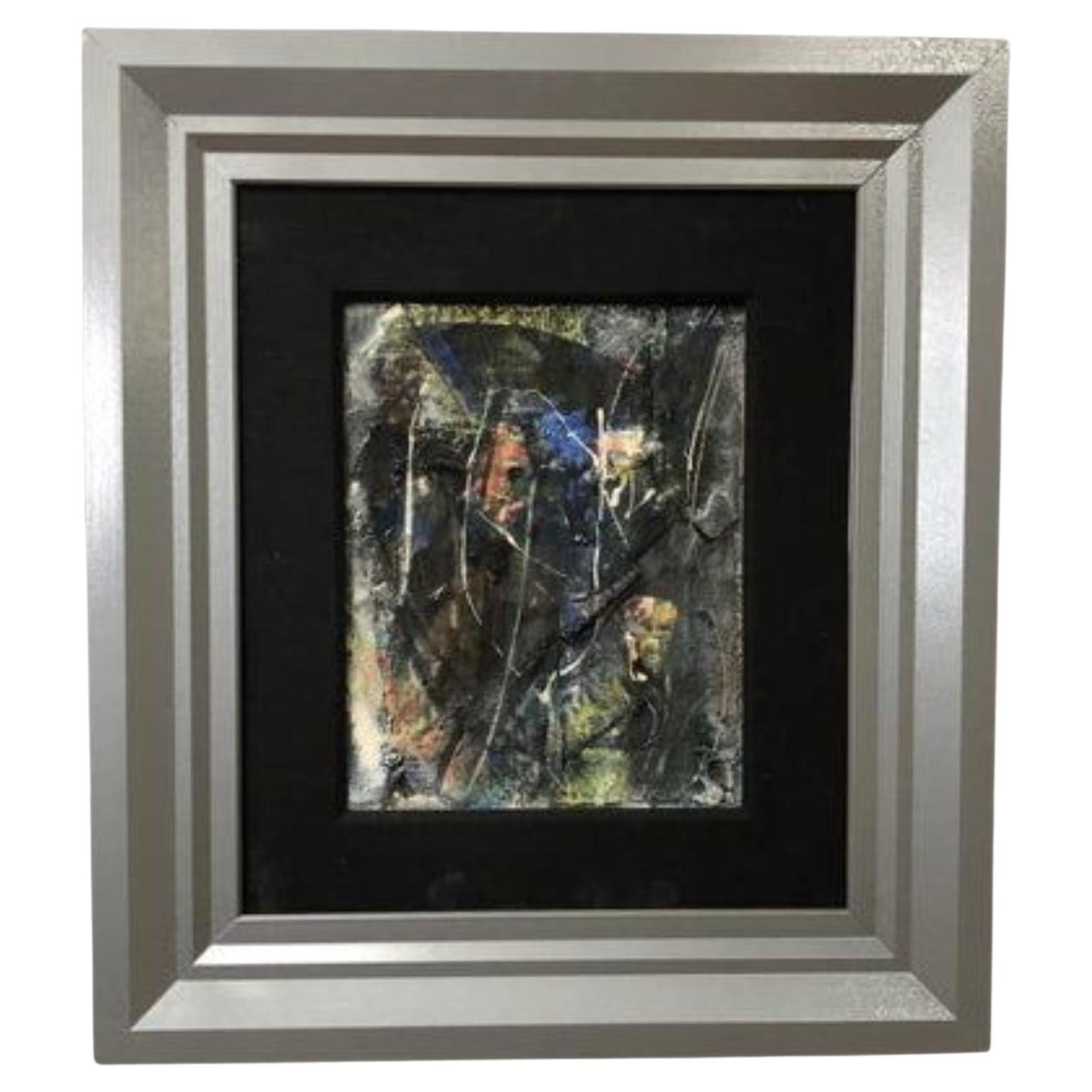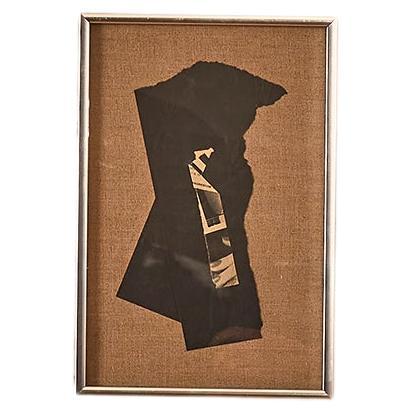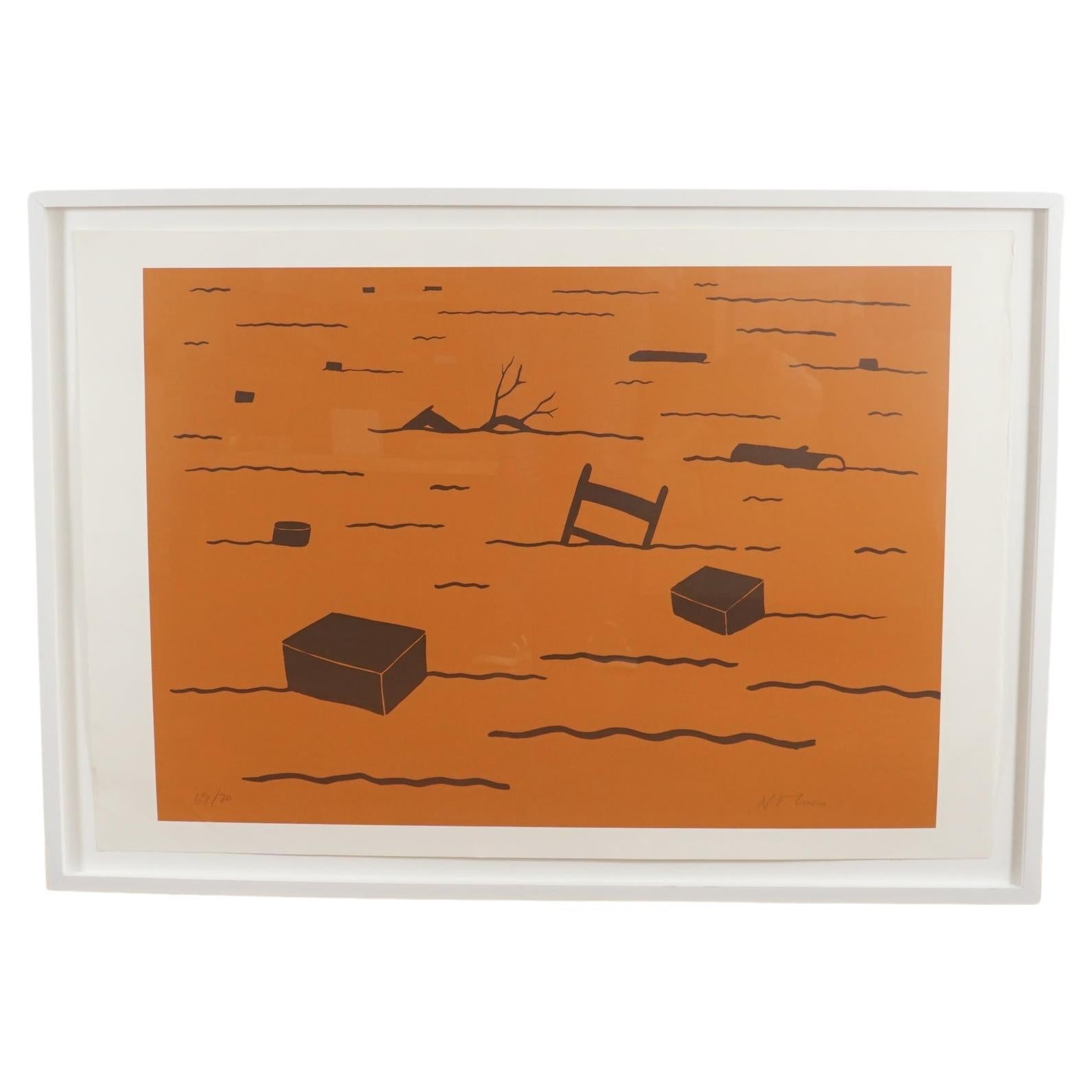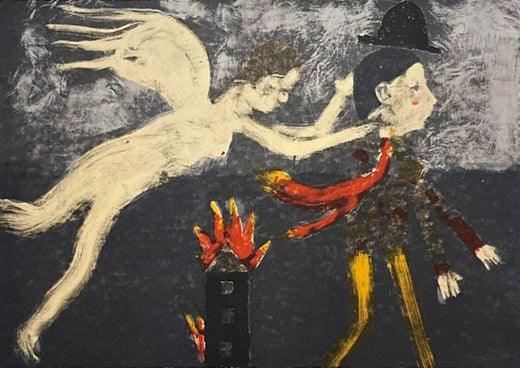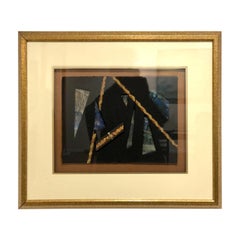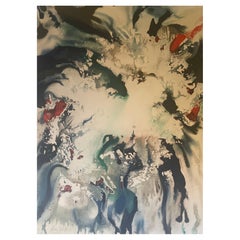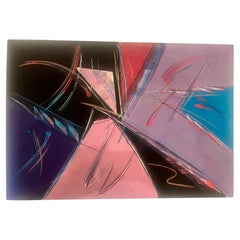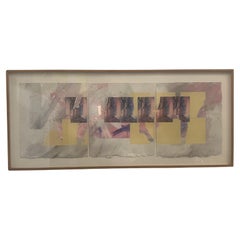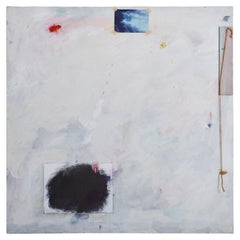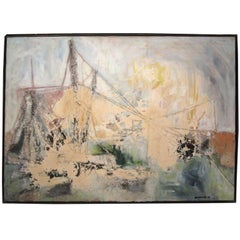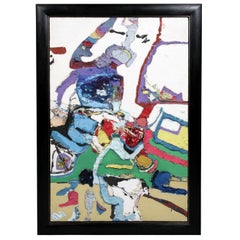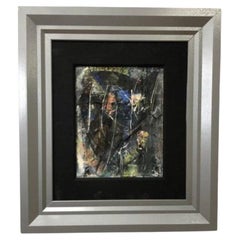Items Similar to Mixed Media Entitled "W.D. Snodgrass Come out of the Storm" by Deloss Mcgraw
Want more images or videos?
Request additional images or videos from the seller
1 of 16
Mixed Media Entitled "W.D. Snodgrass Come out of the Storm" by Deloss Mcgraw
$750
£568.29
€650.93
CA$1,062.29
A$1,159.21
CHF 608.02
MX$14,078.93
NOK 7,594.54
SEK 7,177.22
DKK 4,858.28
About the Item
Original mixed media entitled "W.D. Snodgrass Come out of the Storm" by Deloss Mcgraw, circa late 1970s. The piece is in very good vintage condition and comes unframed; it measures 21.5"W x 27.5"H. It is titled, signed and numbered 3 / 10 at the bottom of the art work. Super cool rare piece! #4326
Painter and poet Deloss McGraw has been a pioneer in the art and poetry collaborative movement since the 1980s. McGraw migrated to California from Oklahoma in order to attend Long Beach State University and the Otis Art Institute. In addition, he studied at Michigan’s Cranbrook Academy of Art, from which he graduated in 1973 with an MFA.
In 1976, McGraw discovered the work of Pulitzer Prize-winning poet W.D. Snodgrass. McGraw sent Snodgrass a series of mixed media paintings that incorporated the poet’s text into their compositions. Snodgrass, in turn, responded with new poems inspired by these images, and thus occurred a melding of media and ideas between the aritsts.
Since then, McGraw has developed a pictorial style in which recognizable forms are morphed by his imagination into objects of poetic fancy. His figuration has been greatly inspired by so-called ‘outsider art,’ most notably by the work of American folk artists that McGraw has collected since his childhood. It is from these that the artist’s paintings have derived their rough-hewn quality.
Deloss McGraw’s work has been exhibited extensively throughout the United States and Europe. His pieces have received critical acclaim in over 80 solo exhibitions, and are collected by such eminent institutions as: Oxford, Syracuse, Temple and Cornell Universities, as well as by the Whitney Museum of American Art Library Collection, The Library of Congress, the San Diego Museum of Art, and the Scottsdale Museum of Contemporary Art. Two of McGraw’s works belong to the Metropolitan Museum of Art. His illustrated version of Alice in Wonderland won the Illustrator’s Society Book of the Year Award for 2002.
WHEN TWO ARTS INTERACT: Poet W.D. Snodgrass, artist DeLoss McGraw
Christian Science Monitor 12/17/1987
It was a collaboration that began with a fan letter: a note from an unknown artist to a Pulitzer Prize-winning poet. DeLoss McGraw, a budding watercolorist and art teacher, wrote to W.D. Snodgrass, a ranking member of the Confessional School of Poetry, asking permission to use the poet's name in a series of paintings inspired by Mr. Snodgrass's award-winning collection, ``Heart's Needle.'' From those two initial watercolors in 1981 - ``W.D. Snodgrass, You Sentimental Fool'' and ``Silly Man, Come Out of the Storm'' - grew an exceptionally fertile, and largely unprecedented, artistic collaboration. The resulting series of paintings and poems, entitled ``Who Killed Cock Robin?,'' proved to be some of the more significant work each artist has produced.
For Mr. McGraw, the paintings were among his first to become commercially successful. For Snodgrass, the poems are among the most lyrical he has written, and represent a fresh burst of creativity 25 years after his initial success.
Although the two artists live at opposite ends of the country - Snodgrass in Delaware and McGraw in southern California - and have met infrequently, they continue to collaborate. The Cock Robin poems are included in Snodgrass's most recent anthology, ``Selected Poems, 1957-1987.'' And next spring, the University of Delaware will issue the first volume of poems and paintings, ``Who Killed Cock Robin?''
Oklahoma-born McGraw still speaks with a native drawl reinforced by a California casualness. He wears a rakish bow tie, sneakers, and no socks, and talks in animated bursts. Snodgrass, who continues to teach at the University of Delaware, is a classic 'eminence grise. Tall and silver-haired, he sports a flowing, Karl Marx-ish beard and a sotto voce demeanor. Both men showed great humor and deference - and a slight tendency to disagree - during the following interview. The discussion took place with Hilary DeVries in Philadelphia, after a reading by Snodgrass of his poems, in ``The Death of Cock Robin?,'' at the Giannetta Gallery.
This is the first time you two had ``performed'' together, isn't it?
McGraw: I had not heard you read your works until last night.
Snodgrass: Oh, that can't be true!
McGraw: I had only heard a tape. It was very interesting to hear you comment on the paintings. Sometimes you could not be farther from the truth, other times you were right on target.
De [Snodgrass], your poems have undergone a major stylistic and thematic change since collaborating with Del. What was it that first attracted you to his paintings, other than the fact that they were about your poems?
Snodgrass: I hadn't written light things, in a way virtuoso things, since the beginning of my career. I had finished a big cycle of poems on the Nazis called ``The Fuehrer Bunker'' and I thought I would leave it and go on. ... But it also has to do with Del's paintings and their quality of playfulness. Del, I think, wants to keep a quality of improvisation in his work all the time, a sort of tossed-offness. Usually, I might be working on a poem for 10, 12, 20 years, and most of it is very carefully planned and plotted ahead of time.
Del, what first attracted you to De's poetry?
McGraw: I had read De's work in college and responded to it. Later, when I was going through a divorce and I was looking around for someone I could identify with, I picked up ``Heart's Needle'' again, which is about him losing his child during a divorce, and that was it. I had read enough of his work so that I saw the two sides: I saw a darkness and a lighter side.
I had never seen De's work as dark as everyone said. I gave a talk about De and a man came up to me and said, ``How do you two get along? He's so dark.'' And I said I'd never seen him as dark. He's got a great sense of irony; he will laugh at himself. He talks about darkness, but the only way he can look at it for a lifetime is with humor.
At the time, my whole life was about a 12-year marriage with three children that I had to leave ... and De was able to speak of these things with a certain amount of gentleness or humor or irony. That's the way I read the poems.
It's amazing; people still don't understand the way I work. They see it as light. But I'm not Peter Max! I feel in my work that I deal with very serious issues. I just think that the way to approach them is through the back door. And that means being a little humorous in my approach to painting, to be childlike. You're not hitting the viewer with a 20-pound sledge, but with a little hammer.''
Snodgrass: For you, childlike is always good. And it isn't so for me. But there is always humor present and a seriousness. ... It's easy to get to wallowing in your own seriousness, and that's dangerous. For me, after having immersed myself in something very heavy, I did feel like coming out and kicking up my heels.
How does this stylistic similarity affect your individual artistic processes?
McGraw: That's what so interesting about art: you have to work out from this situation that you've lived through. And maybe you wouldn't pick the life that you've lived. But if you're honest, you're forced to respond to it. Even though I do extract images from his writings, it has to be sifted through my own life experience.
The way I work with his poems is, I read through and find some thread that I'm interested in and I circle certain words in different-colored pencils and then I go to the dictionary and the thesaurus and I take it as far as I can. I have to do that before I can come up with images. I did that with one poem of his, and the circled words became the title of the painting.
And how does the poet work?
Snodgrass: Any way he can! I don't know that it ever goes the same way twice. I just want to be fired off; I'm not picky about how ... a chain of associations, whatever will do that, I'll take it and go with it. Very often Del and I misunderstand each other. And should. For example with your big triptych, ``Who Killed Cock Robin?,'' I hadn't known what the title of the painting was and I had just looked at it and sort of free-associated and come up with something quite different from what the painting is really about.
And it's quite right for you to take whatever you can from my writing, whether it has much to do with what my writing is about or not. You know, your painting called ``The Locked House''? It has almost nothing to do with my poem, which is about who is responsible for the bust-up of a marriage.
McGraw: I saw that house as home, the poet's sense of home. I tried to make that house [in my painting] warm and glowing. The little windows are not dark; they're illuminated. And I've got that candy-coated thorn guarding it. That's what I thought you were doing in the poem. You felt bad that all these things were [happening in your marriage], when actually the vandals [a threatening image in the poem] were ourselves.
Snodgrass: Yeah, sure. We should have known that the danger wasn't from the vandalism from outside but from our own vandalism.
Can you give an example of what the painter has learned from the poet?
McGraw: De knocked me out with ``Storm Family's Anthem,'' which he wrote after seeing the chair that I had used in several paintings and hadn't known was the chair that my grandmother had rocked me in. We didn't have a rocking chair. We didn't have a lot of money, and my grandmother had rocked me in a straight-backed chair. I didn't know that was what I had been painting until he nailed it in the poem.
Snodgrass: Yes, that poem was in response to the chair. And Del sees things all the time in my work that I hadn't seen but which now I do see.
You've been called a ``painter's heir to Whitman.'' And many of your images also come from a strong folk art tradition, don't they?
McGraw: Oh, absolutely.
Snodgrass: I've always seen Whitman as the competition. He's our greatest poet by far, and I've got to beat him, that sort of thing.
McGraw: I began painting in that terrible period of minimalism. And I was painting striped paintings and I never knew when to end them. You're laughing, but it was true. For the paintings with De's work I write a sentence, a fragment actually; I lay down the pencil image in five minutes and I lay in the flat [color], and if I think it's going to work I pin it up on the wall and I start another one. But while I was at Cranbrook Academy of Art, I saw a folk art exhibit, including a sculpture of a horse and a black man, and I thought, ``This is great. The artist has made this for one reason - he had to.''
I started collecting folk art in that era, which brings me to a point. When I visited De in upstate New York, I looked at his collection of records and things that interested him and he had these wonderful primitive carvings, painted in primary colors, and I would have bought them, no doubt about it. I said to De, ``Isn't it odd that we're alike?'' And he said, ``Of course not!''
So your connection has as much to do with personality and taste as it does with purely artistic concerns?
McGraw: Yes, those things that we choose to surround ourselves, the art on his walls, the music that he picks. For example, I spent money on my daughter's piano lessons and I really wanted her to play the harpsichord. And De's wife, Kathy, plays the harpsichord wonderfully. He loves the recorder; I would love to have the time to play. So we have a whole base that's similar.
Snodgrass: It also has to with the fact that we're both basically middle-class, monogamous men who sometimes get into periods when we don't seem that way at all. But the important thing is... He doesn't try and control how I respond to his painting, and I don't control his response to my poems. I'm just glad to have him respond. I'm not the authority on my poems, anyway.
McGraw: This is what is great about this man; this dribbly 35-year-old painter comes to him responding and working and he has the humility...
Snodgrass: Oh, come on!
McGraw: No, he's the man who buys so much of my work and has allowed me in four years to travel so far. And I'd be interested in this, you've had other artists who wanted to work with you.
Snodgrass: Yeah, but they didn't have the kind of attitude you do. With you I can go my way. I'm free to misunderstand you and you are free to misunderstand me.
What do the specific constraints of your individual art forms have to do with the success of this collaboration? In other words, why a dialogue between a poet and a painter instead of the other disciplines?
Snodgrass: I think there is a good reason. A poem is so compressed, with so many different images in there, that it can take you in all sorts of directions other than the direction that it may take a regular reader.
McGraw: I have to read and read and sit around for days waiting for something to come from a novel or a play. They aren't explosive at all. And what I tend to want to do, which isn't right, is illustrate. When I read a poem, I have no desire to illustrate it.
Snodgrass: A poem can send you off in odd angles from its own direction. It can explode you off into side alleys.
McGraw: I don't care for illustration, because there is nothing of me there. As an artist, I have to respond with my own life experience.
- Creator:DeLoss McGraw (Artist)
- Dimensions:Height: 27.5 in (69.85 cm)Width: 21.5 in (54.61 cm)Depth: 0.1 in (2.54 mm)
- Style:Modern (In the Style Of)
- Materials and Techniques:
- Place of Origin:
- Period:
- Date of Manufacture:1970s
- Condition:Wear consistent with age and use.
- Seller Location:San Diego, CA
- Reference Number:Seller: #43261stDibs: LU936645062102
DeLoss McGraw
DeLoss McGraw is an American artist known for his whimsical gouache paintings. Inspired by his own poetry as well as poems by W.D. Snodgrass, McGraw’s dreamlike works are often reminiscent of painting by Paul Klee. Klee like McGraw, was inspired by the works of folk artists and children. Born in 1945 in Okemah, OK, he went on study at the Otis Art Institute in Los Angeles and received his MFA from the Cranbrook Academy of Art in 1973. McGraw lives and works between Los Angeles, CA and Okemah, OK. Today, his works are in the collections of The Metropolitan Museum of Art in New York, the Cranbrook Museum of Art in Bloomfield Hills, MI, and the Library of Congress in Washington, D.C., among others.
About the Seller
4.9
Platinum Seller
Premium sellers with a 4.7+ rating and 24-hour response times
Established in 2000
1stDibs seller since 2012
4,258 sales on 1stDibs
Typical response time: <1 hour
- ShippingRetrieving quote...Shipping from: San Diego, CA
- Return Policy
Authenticity Guarantee
In the unlikely event there’s an issue with an item’s authenticity, contact us within 1 year for a full refund. DetailsMoney-Back Guarantee
If your item is not as described, is damaged in transit, or does not arrive, contact us within 7 days for a full refund. Details24-Hour Cancellation
You have a 24-hour grace period in which to reconsider your purchase, with no questions asked.Vetted Professional Sellers
Our world-class sellers must adhere to strict standards for service and quality, maintaining the integrity of our listings.Price-Match Guarantee
If you find that a seller listed the same item for a lower price elsewhere, we’ll match it.Trusted Global Delivery
Our best-in-class carrier network provides specialized shipping options worldwide, including custom delivery.More From This Seller
View AllOriginal Frame Mix-Media Abstract Wall Decor by Artist Harris Strong Signed
By Harris Strong
Located in San Diego, CA
Nicely frame in all original condition rare pieces by listed artist Harris Strong, great condition, circa 1980s signed and numbered. Memphis Collage.
Category
20th Century American Post-Modern Decorative Art
Materials
Glass
$540 Sale Price
20% Off
MCM Expressionist Abstract Lithograph by Don Fink
Located in San Diego, CA
Bright expressionist abstract lithograph by listed artist Don Fink, circa 1960s. The piece is unframed and measures 20.5" x 27.75" and is in very good vintage condition. The print is...
Category
20th Century North American Mid-Century Modern Prints
Materials
Paper
$2,000 Sale Price
20% Off
Postmodern Memphis Era Original Abstrac Signed Large Litho Unframed Circa 1980's
By Ettore Sottsass
Located in San Diego, CA
Nice design beautiful colors and excellent condition on this signed litho we cant find who is the artist , never framed easy to ship the image by itself is 22"x32" circa 1980's nice ...
Category
20th Century American Post-Modern Prints
Materials
Paper
Framed Postmodern Abstract Lithograph circa 1980's Memphis Era
Located in San Diego, CA
nicely museum quality framed Litho circa 1980's mixed medis on maple frame with lucite top great colors abstract subject.
Category
20th Century American Post-Modern Decorative Art
Materials
Lucite, Maple, Paper
1963 Original Framed Acrylic on Board by Richard Allen Morris Listed Artist
By Richard Allen Morris
Located in San Diego, CA
Abstract rare acrylic on canvas by Richard Allen Morris Signed and dated on top as shown beautiful frame , California design listed artist .
Category
20th Century American Mid-Century Modern Paintings
Materials
Wood
Original Abstract Serigraph Signed Dated 1959 Title by Robert Alan Smith
Located in San Diego, CA
Large and rare signed and dated 1959 title Light in the Oaks, by listed artist Robert Alan Smith, unframed the condition its good with some stains on...
Category
20th Century American Mid-Century Modern Prints
Materials
Paper
$380 Sale Price
20% Off
You May Also Like
Riding the Storm by Maxine Snider, 1990s
Located in Chicago, IL
A large scale abstract mixed media painting on canvas by Chicago artist Maxine Snider, 1990s. Signed en verso.
Maxine Snider is a Chicago artist and d...
Category
1990s American Mid-Century Modern Paintings
Materials
Paint, Canvas
"Storm at Sea" Mid Century PaInting by J.Domokur
By Jerry Domokur
Located in Water Mill, NY
Mid Century Mixed media painting "Storm at Sea" by J.Domokur in heavy gage brass frame.40x34
Category
Vintage 1960s American Paintings
Materials
Canvas
Mixed-Media Painting by Louis Schiavo
By Louis Schiavo
Located in London, GB
Mixed-media on board on gesso ground, in gouache and oil using the impasto technique.
The work also includes areas of collage using applied materials beneath the paint to add depth ...
Category
Vintage 1950s Corsican Mid-Century Modern Paintings
Materials
Canvas
Original Merton Simpson Multi-Media
By Merton Simpson
Located in Newmanstown, PA
Merton Simpson Multi-Media 27" x 24". Merton Daniel Simpson (September 20, 1928, March 9, 2013) was an American abstract expressionist painter and African and tribal art collector an...
Category
Vintage 1980s American Paintings
Materials
Wood
Mixed Media Collage by Chet Lamore, circa 1978
Located in Long Island City, NY
Untitled mixed media collage by Chet Lamore, circa 1978. Signed Lamore on the lower center.
Category
20th Century American Contemporary Art
Materials
Marble, Metal
Nicholas Monro, "The Flood" Signed Screen Print
By Nicholas Monro
Located in Hudson, NY
British pop art sculptor, print-maker and teacher, Nicholas Monro, completed this work in the 1970s. Titled "The Flood," it is an original pencil sig...
Category
Vintage 1970s English Post-Modern Prints
Materials
Paper
More Ways To Browse
Vintage Sneaker
Black And Silver Bow Heels
Sock Sneaker
Grandmothers Chair
Taos Furniture
Three Bird Art
Tobacco Tins
Tramp Art Frame
Used Stock Pot
Vintage Barkcloth
Vintage Daughter And Father
Vintage Garter
Vintage Glass Bowl With Flowers
Vintage Laminate Sheets
Vintage Paris Decor
Vintage Pedestal Dish
Whatnot Stand
Woodard Aluminum

